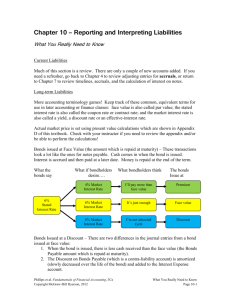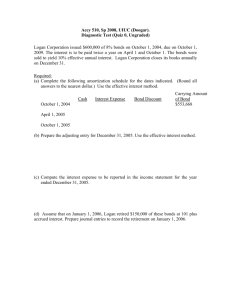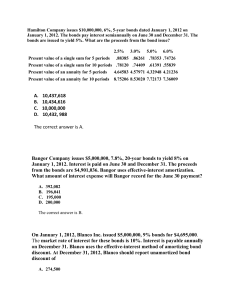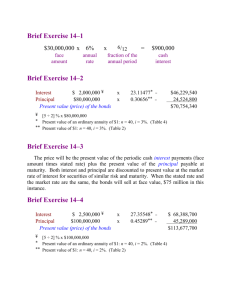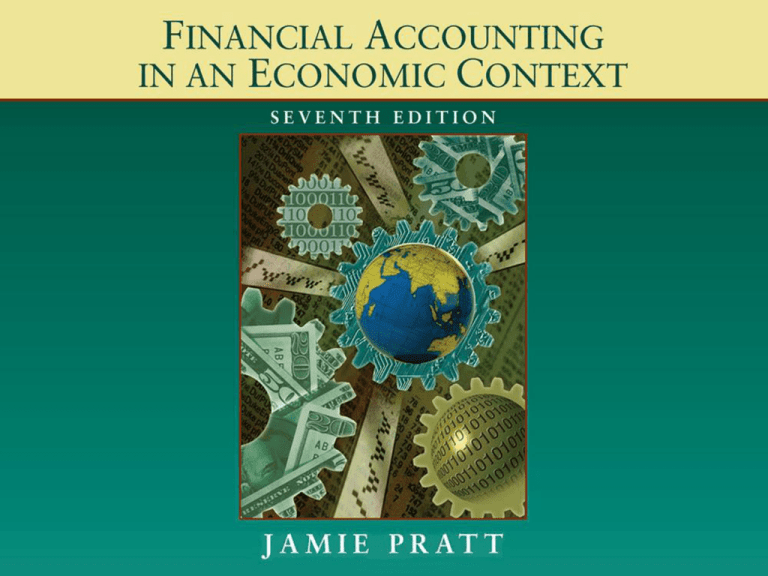
1
Ch 11: Long-Term Liabilities
Notes, Bonds, and Leases
Long-term liabilities are recorded at the present value of
the future cash flows.
Two components determine the “time value” of money:
– interest (discount) rate
– number of periods of discounting
Types of activities that require PV calculations:
– notes payable
– bonds payable and bond investments
– capital leases
2
1.Present Value of a Single Sum
All present value calculations presume a discount
rate (i) and a number of periods of discounting (n).
There are 3 different ways you can calculate the PV1:
n
1. Formula: PV1 = FV1 [1/(1+i) ]
2. Tables: See Page 684, Table 4
3.Calculator if it has time value of money functions.
3
Long-term Notes Payable
Problem 1: On January 2, 2008, Pearson Company
purchases a section of land for its new plant site. Pearson
issues a 5 year non-interest bearing note, and promises to
pay $50,000 at the end of the 5 year period. What is the
cash equivalent price of the land, if a 6 percent discount
rate is assumed?
PV1 = 50,000 ( 0.74726) = $37,363
[ i=6%, n=5]
Journal entry Jan. 2, 2008:
Dr. Land
37,363
Dr. Discount on N/P
12,637
Cr. Notes Payable
50,000
4
Problem 1 Solution, continued
The Effective Interest Method:
Interest Expense =
Carrying value x Interest rate x Time period
(CV)
(Per year)
(Portion of year)
Where carrying value = face - discount.
For Example 1, CV= 50,000 - 12,637 = 37,363
Interest expense = 37,363 x 6% per year x 1year
= $2,242
5
Problem 1 Solution, continued
Journal entry, December 31, 2008:
Interest expense
2,242
Discount on N/P
2,242
Carrying value on B/S at 12/31/2008?
Notes Payable
Discount on N/P
$50,000
(10,395)
$39,605
(Discount = $12,637 - 2,242 = $10,395)
6
Problem 1 Solution, continued
Interest expense at Dec. 31, 2009:
39,605 x 6% x 1 = $2,376
Journal entry, December 31, 2009:
Interest expense
2,376
Discount on N/P
2,376
Carrying value on B/S at 12/31/2009?
Notes Payable
$50,000
Discount on N/P
(8,019) $41,981
(Discount = 10,395 - 2,376)
Carrying value on 12/31/2012 (before retirement)?
$50,000
7
2. Present Value of an
Ordinary Annuity(PVOA)
PVOA calculations presume a discount rate (i), where
(A) = the amount of each annuity, and (n) = the
number of annuities (or rents), which is the same as
the number of periods of discounting. There are 3
different ways you can calculate PVOA:
1. Formula: PVOA = A [1-(1/(1+i)n)] / i
2. Tables: see page 685, Table 5
3.Calculator if it has time value of money functions.
8
Problem 2: Bonds Payable
On July 1, 2007, Mustang Corporation issues
$100,000 of its 5-year bonds which have an annual
stated rate of 7%, and pay interest semiannually
each June 30 and December 31, starting December
31, 2007. The bonds were issued to yield 6%
annually.
Calculate the issue price of the bond:
(1) What are the cash flows and factors?
Face value at maturity = $100,000
Stated Interest =
Face value x stated rate x time period
100,000 x 7% x (1/2) = $3,500
Number of periods = n = 5 years x 2 = 10
Discount rate = 6% / 2 = 3% per period
9
Problem 2 - calculations
PV of interest annuity:
PVOA Table
PVOA = A(
PVOA Table
) = 3,500 (8.53020) = $29,856
i, n
i = 3%, n = 10
PV of face value:
PV1 Table
PV =FV1(
PV1 Table
) = 100,000 (0.74409)=$74,409
i, n
Total issue price =
i=3%, n=10
$104,265
Issued at a premium of $4,265 because the
company was offering an interest rate greater than
the market rate, and investors were willing to pay
more for the higher interest rate.
10
Problem 2 - Amortization Schedule
To recognize interest expense using the effective interest
method, an amortization schedule must be
constructed. (This expands the text discussion.)
To calculate the columns (see next slide):
Cash paid = Face x Stated Rate x Time
= 100,000 x 7% x 1/2 year = $3,500
(this is the same amount every period)
Int. Expense =
CV x Market Rate x Time
at 12/31/07 = 104,265 x 6% x 1/2 year = 3,128
at 6/30/08 = 103,893 x 6% x 1/2 year = 3,117
The difference between cash paid and interest expense
is the periodic amortization of premium.
Note that the carrying value is amortized down to face
value by maturity.
11
Problem 2 - Amortization Schedule
Date
7/01/07
12/31/07
6/30/08
12/31/08
6/30/09
12/31/09
6/30/10
12/31/10
6/30/11
12/31/11
6/30/12
Cash
Paid
3,500
3,500
3,500
3,500
3,500
3,500
3,500
3,500
3,500
3,500
Interest
Expense
3,128
3,117
3,105
3,093
3,081
3,069
3,056
3,042
3,029
3,015
Carrying
Difference Value
104,265
372
103,893
383
103,510
395
103,115
407
102,708
419
102,289
431
101,858
444
101,414
458
100,956
471
100,485
485
100,000
12
Problem 2 - Journal Entries
JE at 7/1/07 to issue the bonds:
Cash
104,265
Premium on B/P
4,265
Bonds Payable
100,000
JE at 12/31/07 to pay interest:
Interest Expense
Premium on B/P
Cash
3,128
372
3,500
Note that the numbers for each interest payment
come from the lines on the amortization schedule.
13
Bonds Payable at a Discount
If bonds are issued at a discount, the carrying
value will be below face value at the date of
issue.
The Discount on B/P account has a normal debit
balance and is a contra to B/P (similar to the
Discount on N/P).
The Discount account is amortized with a credit.
Note that the difference between Cash Paid and
Interest Expense is still the amount of
amortization.
Interest expense for bonds issued at a discount
will be greater than cash paid.
The amortization table will show the bonds
amortized up to face value.
14
Problem 2 - Retirement of Bonds
Assume that Mustang’s bonds were retired on June 30,
2008 (after the interest payment). Mustang
Corporation paid $104,000 to retire the bonds from the
marketplace. Record the entries on June 30, 2008.
JE at 6/30/08 to pay the interest:
Interest Expense
Premium on B/P
Cash
3,117
383
JE at 6/30/08 to retire the bonds:
Bonds Payable
100,000
Premium on B/P
3,510
Loss on Retirement
490
Cash
3,500
104,000
15
3. PV of an Annuity Due (PVAD)
The difference between an ordinary annuity and an annuity due is
the timing of the periodic payments: an annuity due has
payments (rents, annuities) at the beginning of each period.
The result is that there is one less period of discounting.
There are 3 different ways you can calculate PVAD:
n-1
1. Formula: PVAD = A [((1-(1/(1+i) )) / i) + 1]
2. Tables: see page 686, Table 6
PVAD Table
PVAD = A(
)
i, n
where n = number of payments (not periods)
3.Calculator if it has time value of money functions.
16
Leases
FASB issued SFAS No. 13, which requires certain
leases to be recorded as capital leases.
– Capital leases record the leased asset as a capital
asset, and reflect the present value of the related
payment contract as a liability.
Requirements of SFAS No. 13 - record as capital lease for
the lessee if any one of the following is present in the
lease:
– Title transfers at the end of the lease period,
– The lease contains a bargain purchase option,
– The lease life is at least 75% of the useful life of the
asset, or
– The lessee pays for at least 90% of the fair market value
of the lease.
17
Problem 3 - Leases
Lee Company (the lessee) signed a contract to lease equipment
from Lawrence Company (the lessor). The terms of the lease
were as follows:
1. Four year lease starting January 1, 2008.
2. Annual lease payments of $6,000. The first payment is due at
lease inception (January 1, 2008), with subsequent payments
on December 31, 2008, 2009, and 2010.
3. Bargain purchase option of $1,000 at end of lease (December
31, 2011).
Other information:
Lee’s borrowing rate: 8%
Useful life of equipment: 6 years with no salvage value.
18
Problem 3 - Leases
Requirement 1: Calculate the PVMLP
(Note that the lease payments are an annuity due.)
PVMLP = PV RENTS + PVBPO
PVAD Table
PV RENTS =PVAD= A(
PVAD Table
) = 6,000(3.5771) = $21,463
i, n
i =8%, n=4
PV1 Table
PVBPO = PV1 = FV1(
PV1 Table
) = 1,000(0.73503) = $ 735
i, n
i = 8%, n = 4
The present value of the minimum lease pmts = $22,198
19
Problem 3 - Leases
Date
1/01/08
1/01/08
12/31/08
12/31/09
12/31/10
12/31/11
Cash
Paid
Interest
Expense
6,000
6,000
6,000
6,000
1,000
-0- 1
1,2962
920
513
733
Carrying
Difference Value
22,198
6,000
16,198
4,704
11,494
5,080
6,414
5,487
927
927
-0-
1No
interest at 1/1/08, because no time has passed.
This is equivalent to a “down payment” which
immediately reduces the total liability.
2Int.
Expense = CV x MR x T = 16,198 x 8% x 1 year
3Rounding
difference of $1 absorbed in calculation.
20
Problem 3 - Leases
Requirement 3: Prepare the following journal
entries for the year 2008:
Initial lease at 1/1/08:
Equipment
22,198
Lease Liability
22,198
First payment at 1/1/08:
Lease Liability
6,000
Cash
6,000
Second payment at 12/31/08:
Interest Expense
1,296
Lease Liability
4,704
Cash
6,000
21
Problem 3 - Leases
For the last entry, we must calculate straightline depreciation on leased asset at
12/31/08.
Note that the calculation here is based on the
length of time that the lessee will actually
use the asset (6 years here because of the
BPO).
(Cost-SV)/Est. life =(22,198 - 0)/6 = $3,700
JE for Depreciation at 12/31/08:
Depreciation expense
Accumulated Depr.
3,700
3,700
22
Copyright
© 2008 John Wiley & Sons, Inc. All rights reserved.
Reproduction or translation of this work beyond that
permitted in Section 117 of the 1976 United States
Copyright Act without the express written permission
of the copyright owner is unlawful. Request for further
information should be addressed to the Permissions
Department, John Wiley & Sons, Inc. The purchaser
may make back-up copies for his/her own use only
and not for distribution or resale. The Publisher
assumes no responsibility for errors, omissions, or
damages, caused by the use of these programs or
from the use of the information contained herein.
23

